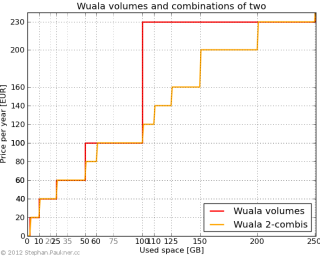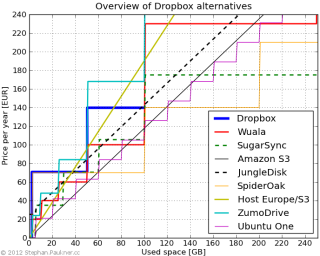Monday, January 23. 2012

Since I plan to back up my worthy RAW pictures into the cloud (Why?), I collected some reference values of various cloud storage providers with the following important conditions in mind:
- Support for GNU/Linux
- Support for Android
- Available for Europeans
The following graph lists the various providers I found and plots their available volume packages against their prices:
In the following I provide a short summary for each provider, and a conclusion of my personal considerations.
- Dropbox: 2 GB free, 50 GB for €70 ($100) per year, no smaller plans; 100 GB for ×2. Provides web UI. Big plus is a file undelete/versioning feature. Big minus is the lack of file encryption.
Probably the best-known name, probably deserved due to its simplicity, availability on all major platforms and their referral system to increase one’s free space. However, once you really want more space, Dropbox depicts an upper bound for all providers. In addition, there aren’t any volume packages above 100G available for individuals.
- SugarSync has better pricing (5G free, 30G for €35 ($50), 60G for ×2, 100G €105 ($150), 250G €175 ($250)) + an Android app, but no Linux client (except 3rd party alpha written in PHP...
 ) )
- Wuala has Android + Linux and good pricing for small/med plans (2G free, 10G €20, 25G €40, 50G €60, 100G €100, 250G €230, 500G €400). Provides Java “web” UI, no HTML due to security reasons. Also implements undelete (via trash can) and file versioning. Files are always encrypted. Their location in Switzerland is another sympathy bonus.
I’m not too happy about their decision for Java though, given that Sun’s JVM is considered obsolete, but recommended (in their forums).
- Amazon S3 is a little outsider in this setting, as the integration into a local file system via their API is technically rather cumbersome; s3fs didn’t work for me, only s3cmd on the command line. The advantage is that you only pay for allocated space, namely €0.098/GB/month ($0.14); that’s why it shows up as a truly linear graph. No file versioning.
- JungleDisk is based on S3 as storage provider, yielding the same volume prices, but adding easy file system integration with a base fee of €2.10/month ($3). But not for Android; the S3 API won’t help, as all files are encrypted. And apparently it’s not available outside the US.
- SpiderOak offers 2G free, every 100G for €70 ($100), no smaller plans. But despite those high volume increments, they are (mostly) cheapest if you need >60G. Mobile clients are still young, though; users report crashes and miss the upload feature. Thus, I plotted the graph only with a thin line, as it’s not really an option yet.
- Host Europe’s cloud offers €0.15/GB/month with S3-compatibility, which again means cumbersome clients with manual sync. In addition, data transfer is for €0.10/GB. Since everything you store is also uploaded once, this makes the curve quite steep—I show that total amount in the graph, not just the plain storage price. No web UI, no file versioning. A plus OTOH is that they’re German.
The Android app S3Anywhere has added dedicated support for Host Europe (besides Amazon S3 of course).
- ZumoDrive: 2G free, 10G €25 ($36), 25G €60 ($84), 50G €84 ($120), 100G ×2. Extrapolates the Dropbox curve in some sense (and is more expensive due to monthly accounting), but offers lower volumes for lower prices.
- Ubuntu One: 5G free, every 20G for €21 ($30). Add +€7 (+$10) to get a music store + streaming. Provides web UI. However, people say it’s still unreliable, there are problems with sync collisions. Also, it does not support file versioning. Not really an option yet, so only a thin line in the plot, although their small volume packages allow small prices.
- Box.com: Left out in this overview, as it isn’t quite clear whether there’s actual file system integration and automatic sync. It seems everything is handled from (web) client software once files are uploaded. It is more focused on collaboration and appears as a competitor to
- Google Docs: Where’s Google Drive got to? Anyway, 1G free, €0.175/GB ($0.25) per year, which means e.g. 100G for awesome €17.50 ($25)! But without Drive coming, there’s no file sync.
So far, Wuala looks most promising to me. However, the curves in the graph above only show the actual volume packages which increase approximately by powers of two, not the true price that can be achieved by combinations. I didn’t bother checking which of the providers actually allow for those combinations; I only show the possible combinations of two Wuala volume packages:

This is already somewhat close to linear growth; by considering 3-combis you’d even get two more steps at 150–160G and 200–210G. So, e.g., if you only need 150G, you’d get them as 100+50G for €160 instead of having to buy 250G for €230.
Why actually the cloud?
So far, I back up everything onto a plain external harddisk (on-site) and [my RAW photos onto] DVD-RAM disks (off-site). I don’t consider using a NAS (yet), as this is just an on-site scenario, and my PC’s RAID is already redundant. While the DVD-RAMs already implement off-site redundancy, the reliance on physical storage media is becoming obsolete, despite their possibly long physical lifespan. OTOH, if I consider one 4.2G DVD-RAM (labeled “4.7G”) for ~€3, I’d need 24 disks to store 100G, which is ~€72—for the whole span of considered years. Using Wuala’s cloud, that’s €100 for only one year in that span. So, the convenience comes with a price, but it could be worth it—thinking of “24 disks”.
|



mbaierl.com on : PingBack
Stephan Paukner :: syslog on : Zero-knowledge cloud storage considerations
Stephan Paukner :: syslog on : Farewell Wuala, hail Tresorit!